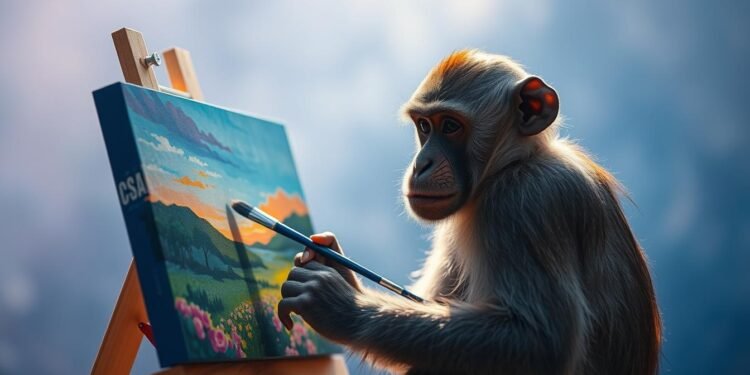As an eloquent author of the editorial team of CSAC.org.uk, I am excited to share with you the art of monkey drawing, a primate art form that has been a favourite among artists for decades. With the rise of digital drawing tools in 2025, monkey drawing has become more accessible and fun, offering a wide range of possibilities for artists of all levels. Did you know that drawing a cartoon monkey can take approximately 30 minutes to 1 hour, and with the right techniques and tools, anyone can create a realistic and captivating monkey portrait, making monkey drawing a great hobby to explore in the world of primate art?
In this article, we will delve into the world of monkey drawing, exploring expert tips and techniques for creating stunning primate art. From understanding the basics of monkey anatomy and proportions to using digital drawing tablets and software, we will cover it all, providing you with the skills and knowledge you need to create impressive monkey drawings and become proficient in monkey drawing and primate art.
Essential Materials and Tools for Monkey Drawing in 2025
When it comes to drawing monkeys, having the right materials and tools can make all the difference. In 2025, artists have a wide range of options to choose from, including traditional art supplies and digital drawing tools. For those looking to create cartoon monkeys, a set of basic art supplies such as pencils, paper, and paints can be a great starting point.
In addition to traditional art supplies, digital drawing tablets and software have become increasingly popular in recent years. These tools offer a range of benefits, including increased precision, flexibility, and convenience. Many artists find that using digital drawing tablets allows them to create more detailed and intricate designs, which can be especially useful when drawing cartoon monkeys.
Traditional Art Supplies
- Drawing Paper
- Pencil
- Eraser
- Black Sketch Pen
- Sharpener
- Crayons or Colored Pencils
- Stable Drawing Surface
Digital Drawing Tools
For those looking to create digital artwork, there are many software options available that can be used in conjunction with digital drawing tablets. Some popular options include Adobe Photoshop and Illustrator, which offer a range of tools and features that can be used to create intricate and detailed designs. Whether you’re drawing cartoon monkeys or realistic portraits, digital drawing tools can be a great way to add precision and flexibility to your artwork.
Emerging Art Technologies
In 2025, emerging art technologies such as virtual reality and augmented reality are also being explored, offering new and exciting possibilities for artists. These technologies allow artists to create immersive and interactive experiences that can be used to showcase their artwork in new and innovative ways. Whether you’re drawing cartoon monkeys or creating realistic portraits, emerging art technologies can be a great way to add an extra layer of depth and complexity to your artwork.
Understanding Monkey Anatomy and Proportions
To create realistic monkey portraits, it’s essential to understand the anatomy and proportions of these fascinating creatures. With over 250 species of monkeys found worldwide, each has unique characteristics that can be captured through art. By studying monkey anatomy, artists can gain a deeper understanding of their subject and create more accurate and captivating drawings.
In 2025, digital drawing tools can help artists achieve precise proportions and anatomy, making it easier to create realistic monkey portraits. Observing videos and photos of monkeys can aid in capturing realistic expressions and movements. Understanding the complexity of a monkey’s head, which poses a challenge even for professional artists, is crucial for creating authentic drawings.
Techniques for rendering fur involve building up layers, indicating a multi-step approach to achieve realistic textures. The use of multiple shades of a similar color is recommended for adding dimension to the fur. A combination of black, white, and brown paint can be used for adding texture to the monkey’s body. The following are key aspects of monkey anatomy to consider when drawing:
- Large head and flexible spine
- Long arms and dynamic poses
- Unique facial features and expressions
- Layered fur textures and shading

By mastering monkey anatomy and proportions, artists can create stunning and realistic monkey portraits that showcase their skill and attention to detail. Whether using traditional art supplies or digital drawing tools, understanding the intricacies of monkey anatomy is essential for creating captivating and authentic drawings.
How to Draw a Monkey: Step-by-Step Guide
Monkey drawing is a fun and creative activity that can be enjoyed by people of all ages. With the help of digital drawing tools and traditional art supplies, creating stunning primate art has never been easier. In 2025, artists can take advantage of emerging technologies to enhance their monkey drawings and bring them to life.
To get started with monkey drawing, it’s essential to understand the basic shapes and structure of the monkey’s body. This includes the head, torso, arms, and legs. By breaking down the monkey’s body into simple shapes, artists can create a solid foundation for their drawing. For example, the monkey’s head can be represented by a circle, while the body can be drawn using a combination of rectangles and curves.
Basic Shapes and Structure
Once the basic shapes are in place, artists can add facial features and expressions to bring their monkey to life. The eyes, nose, and mouth are all crucial elements that can help to create a unique and engaging personality for the monkey. By experimenting with different facial expressions, artists can add emotion and depth to their primate art.
Facial Features and Expressions
In addition to facial features, body positioning and movement are also important aspects of monkey drawing. By capturing the monkey’s dynamic movements and poses, artists can create a sense of energy and movement in their drawing. This can be achieved by using flowing lines and curves to suggest the monkey’s movement and flexibility.

Body Positioning and Movement
Finally, adding fur texture and detail can help to create a realistic and captivating monkey portrait. By using a range of techniques, such as hatching and cross-hatching, artists can create a textured and layered effect that brings their monkey to life. With practice and patience, anyone can create stunning primate art and enjoy the many rewards of monkey drawing.
Advanced Techniques for Realistic Monkey Portraits
To create realistic monkey portraits, artists need to master advanced techniques, including shading, texture, and expression. By using digital drawing tablets and software, artists can achieve precise control over their drawings, creating subtle gradations of tone and texture. In 2025, emerging art technology is being explored, offering new possibilities for creating immersive and interactive monkey portraits.
Some key techniques for creating realistic monkey portraits include:
- Layering and blending to achieve depth and dimension
- Using reference photos to capture the subtleties of monkey expressions
- Experimenting with different digital brushes and textures to create realistic fur and skin
According to the Editors of Publications International, Ltd, learning to draw a monkey in cartoon style can help artists develop the skills needed to create realistic monkey portraits. By combining traditional art supplies with digital drawing tablets, artists can create stunning, realistic monkey portraits that showcase their skill and creativity.

Common Mistakes to Avoid When Drawing Primates
When creating primate art, understanding monkey anatomy is crucial for producing realistic and captivating pieces. With over 260 known species of monkeys, each with unique characteristics, it can be challenging to accurately depict them. In 2025, digital drawing tools can aid artists in achieving precise anatomy and proportions, making it easier to create realistic monkey portraits.
To avoid common mistakes, it’s essential to study the anatomy and proportions of monkeys. For instance, the pygmy marmoset, the smallest monkey, has a distinct body structure, while the mandrill, the largest monkey, has a unique facial features. By understanding these differences, artists can create more accurate and engaging primate art.
Some common mistakes to avoid when drawing primates include:
- Anatomical errors, such as incorrect limb proportions or misplaced facial features
- Proportion problems, like incorrect body size or shape
- Texture and shading issues, which can affect the overall realism of the piece

By being mindful of these common mistakes and taking the time to study monkey anatomy, artists can create stunning and realistic primate art that showcases their skills and attention to detail. Whether you’re drawing a cartoon-style monkey or a realistic portrait, understanding the intricacies of monkey anatomy is essential for creating captivating and believable pieces.












